|
|

This chapter describes how to use the DNM Browser to manage DNS zone data.
This chapter assumes the following:
This chapter describes the following tasks:
Step 1 On Windows NT choose DNM Browser from the Cisco program group.
Step 2 On UNIX platforms:
(a) Make sure your DISPLAY environment variable points to your X server.
(b) Execute the command installation_dir/MultiNet/bin/dnm_browser, where installation_dir is the directory where you installed the CDDM or Cisco Server Suite 1000 software.
Step 3 The DNM user authentication dialog appears (along with the main Browser window):
The Username field contains the default authenticated user name, if any.
Step 4 Enter your user name (if it is not already displayed in the dialog) and password. Click on OK.
If you do not have a DNM user account, see the chapter titled "Configuring the DNM Service" in this guide.
Step 5 If the DNM Server field does not contain the name or IP address of the desired DNM server, double-click on the DNM Server field. The Settings dialog box appears. For information about the server options in the dialog box, see "Changing DNM Browser Preferences" on page 3-21.
Step 6 After the DNM server authenticates you, it transfers its top-level zone, designated by a period (.), to the DNM Browser. The DNM Browser then displays the zone data in the main Browser window as shown in the following example.
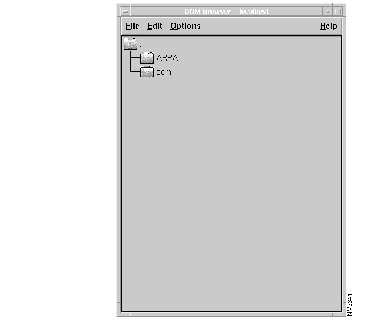
You can now browse, add, and edit DNS records, or add new domains as described in the remainder of this chapter.
Step 7 To stop the DNM Browser, choose Exit from the File menu.
When you start the DNM Browser, you are prompted for a user name and password on the default DNM server. If you choose not to connect to the default DNM server, you can choose a specific DNM server after starting the DNM Browser.
This section describes:
To connect to a DNM server with the DNM Browser:
Step 1 Choose DNM Server... from the Options menu.
The Connection tab of the Settings window appears.
Step 2 Enter the IP address or host name of the desired DNM server in the DNM Server field. This will become the new default DNM server. Host names do not have to be fully qualified.
Step 3 If desired, enter a user name. This will become the new default user name.
Step 4 Click on Connect.
The DNM user authentication dialog appears with the new default DNM server and user name. You can change the default without connecting to the server (see "Changing the Default DNM Server and User Name" on page 3-6).
Step 5 Enter your DNM user password; then click on OK.
If you do not have a DNM user account, see the chapter titled "Configuring the DNM Service" in this guide.
Step 6 After the DNM server authenticates you, it transfers its top-level zone (.) to the DNM Browser, which displays the zone data in the main DNM Browser window.
You can now browse, edit DNS records, or add new domains as described in the remainder of this chapter.
To change the default DNM server or default user name:
Step 1 Choose DNM Server... from the Options menu.
The Connection tab of the Settings window appears.
Step 2 Enter the IP address or host name of the desired DNM server in the DNM Server field. This will become the new default. If you specify a host name it does not have to be fully qualified.
Step 3 If desired, enter a user name. This will become the new default user name.
Step 4 Click on OK.
The DNM Browser will use the new default DNM server and user name the next time you start it.
When you start the DNM Browser, it provides an outline-style view of the domain name space starting with the root domain (.). The Browser obtains the root zone data via a zone transfer.
Note that not all zone data displayed by the DNM Browser is necessarily accessible via DNS. For example, even though your DNM server can store data for the zone yoyodyne.com and your DNS name server requests zone transfers for yoyodyne.com, no host will ask your DNS server to resolve names in yoyodyne.com unless the server is advertised as a name server for yoyodyne.com.
To make your zone's data accessible via DNS, you must also establish your DNS server's authority for the zone. For information on configuring DNS servers, see the chapter titled "Configuring the DNS Service".
The DNM Browser's left-to-right, outline representation of the domain name space differs from the traditional "inverted tree" view of the domain name space presented in most DNS books, but offers the advantage of letting you view selected portions of the domain name space in different levels of detail by expanding (showing) and collapsing (hiding) domains with the mouse.
To expand a domain, double-click the domain's icon. For example, double-clicking the "com" icon expands the com domain as shown in the following figure.
To collapse an expanded domain, double-click its icon again.
You can continue expanding domains to reveal domains lower in the domain name space. For example, to view the hosts in yoyodyne.com, double-click "com," then double-click "yoyodyne." The DNM browser also provides a "find" function that lets you specify the name of a domain you want to edit (see "Editing Records" on page 3-9).
After the DNM Browser receives a zone data transfer from the DNM server, it caches the data. You can then collapse and expand the domain without causing additional zone transfers. The zone data remains cached until its "time-to-live" (TTL) expires. For details on changing the TTL, see "Adding, Modifying, and Deleting Records" on page 3-11.
The DNM Browser lets you manage domains by modifying their DNS records. The icons in the main Browser window indicate whether a domain contains other domains and the types of records in each domain. The DNM Browser provides an online legend of icons that you can open from the Help menu (see the following figure).
For example, the root domain icon in our example indicates that the domain contains additional domains but has no other resource records. The gls.com icon, however, indicates that gls.com contains SOA, MX, and other resource records.
DNM Browser icons give visual clues to the boundaries of zones, and the type of records that are available for the domains they contain.
The icons are very useful for identifying sources of DNS problems. For example, if you add a new domain and several subdomains, the new domain must contain an SOA record or the DNM server will not transfer its data when your DNS servers request it. It is easy to spot the red triangles that indicate SOA records. Similarly, it is easy to spot domains that contain no resource records.

To edit an existing domain's resource records:
When you save your changes, the DNM server increases the serial number for the zone containing the domain. Any DNS servers that are secondary for that zone will notice the new serial number and request a zone transfer from the DNM server.
There are four ways to open a domain for editing:
When you open a domain, a window named "Edit Resource Records for domain" appears. You can edit the records for the chosen domain in this window. For details, see "Adding, Modifying, and Deleting Records" on page 3-11.
You can also edit domains from the Edit pop-up menu by clicking on domain icons with the middle mouse button. The Modify Records command is first on the menu, so you can quickly open domains.
If you are running the DNM Browser on a Windows system equipped with a two-button mouse, use the right mouse button.
When you open a domain, a window named "Edit Resource Records for domain" appears. The following figure shows the window that appears if you open the lot49.com domain in our example.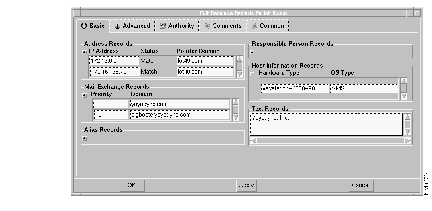
The DNM Browser organizes resource records in a set of five tabs. The following table describes each record type and the tab on which it is located.
To edit resource records, enter new data in the fields provided. Some areas of the Edit Resource Records window, such as the Alias Records area, do not display fields for entering data until you click on the "+" icon. To edit records in multi-record areas, add new fields by clicking on the small "+" icon in the top left of the record area; then enter the record data.
| Tab | Record Type | Description [and Type of Data to Enter] |
|---|---|---|
| Basic | Alias Records | A list of canonical names (CNAMES) pointing to this domain |
| IP Address Records | A host address [IP-address] | |
| Mail Exchange (MB, MG, MINFO, MR and MX) | A mailbox domain name [domain-name], mail group member [domain-name], mailbox or mail list information [request-domain error-domain], mail rename domain name [domain-name], or a mail exchanger [domain name] | |
| Responsible Person | Name of network administrator or user responsible for this domain or host | |
| Host Information (HINFO) | Host information [CPU-type OS-type] | |
| Text (TXT) | Arbitrary text | |
| Advanced | Canonical Name Records (CNAME) | The canonical name for an alias [domain-name]. If you select Canonical Name Records, you cannot specify any other resource records. |
| Pointer (PTR) | A domain name pointer [domain-name] | |
| Well Known Service (WKS) | A well known service description | |
| Unrecognized | Data imported from zone files that contains non-standard records | |
| Authority | Name Server (NS) | An authoritative name server [domain name] |
| Start of Authority (SOA) | The start of a zone of authority [domain of originating host, domain address of maintainer, a serial number and the following parameters in seconds: refresh, retry, expire, and minimum time-to-live (see RFC-1035)] | |
| Comments | Comment | An arbitrary description of the domain |
| Common | Time to Live (TTL) | Duration for which DNS servers store this zone's data |
At any time, you can apply your resource record changes or save them and close the resource record editor window.
If your changes include data that is incomplete or not valid, the DNM Browser prompts you to correct the errors. If your changes do not include any invalid or incomplete data, the DNM server stores the modified domain and increases the serial number on the zone containing the domain. The new zone data will be available via DNS the next time a DNS server that is authoritative for the zone checks the zone's serial number and requests a zone transfer. Note that the interval at which DNS servers check zone serial numbers depends on the zone's SOA record.
The DNM Browser provides two ways to add new hosts, subdomains, and domains to the DNM server:
To add a new host, subdomain, or domain:
Step 1 Choose Add... from the Edit menu.
The Add dialog appears:
The DNM Browser inserts the domain name as the starting point for the new domain name.
Step 2 Enter the complete new host, subdomain, or domain name. For example, instead of entering just whorfin, enter whorfin.yoyodyne.com. If you specify a domain that is in a non-existent domain, the DNM Browser automatically creates the new domain and the new domain's parent domain.
Step 3 By default, the Edit records checkbox is enabled.
Step 4 Click on OK. The DNM Browser adds an icon for the new domain.
If the Edit records checkbox is enabled, the new domain's resource record window opens as well. For information on editing domain resource records, see "Editing Records" on page 3-9.
To create new domains from existing DNS zone files:
Step 1 Copy the zone files to your DNM Browser host.
Step 2 Choose Import Zone from the File menu.
The Import Zone File dialog appears:
Step 3 Enter the name of the zone file. If you specify a relative pathname, it will be relative to the directory you were in when you started the DNM Browser.
Step 4 Enter the name of the domain into which you want to load the zone data.
 | Caution Do not load zone data into an existing domain unless you want to completely replace the existing domain in the DNM service. |
To delete a host, subdomain, or domain from the DNM server:
Step 1 Browse through the domains to display the host, subdomain, or domain you want to delete.
Step 2 Select the one you want to delete.
Step 3 Choose Delete from the Edit menu.
If the domain contains subdomains ("child" domains), you are asked if you want to delete the domain and all its children.
Step 4 If prompted, confirm that you want to delete the domain and its children.
The DNM Browser provides a shortcut to the Domain menu. Click with the middle mouse button (X clients) or right mouse button (Windows) on the domain you want to delete. When the Domain pop-up menu appears, choose Delete.
Use the DNM Browser Rename function to change the name of individual domains or to "move" groups of domains into a new domain.
To rename a host, subdomain, or domain:
Step 1 Browse through the domains to display the host, subdomain, or domain you want to rename.
Step 2 Select the host, subdomain, or domain you want to rename.
Step 3 Choose Rename from the Edit menu. The Rename dialog appears:
The DNM Browser automatically inserts the old name.
Step 4 Enter the new name.
Step 5 Click on OK.
The DNM Browser provides a shortcut to the Edit menu. Click with the middle mouse button (X clients) or right mouse button (Windows) on the domain you want to rename. When the Edit pop-up menu appears, choose Rename.
Use the DNM Browser Reload Domain function to perform a zone transfer for the domain selected in the DNM Browser.
To reload a domain:
Step 1 Browse through the domains to display the domain you want to reload.
Step 2 Click on the domain.
Step 3 Choose Reload Domain... from the Edit menu.
The expanded domain is displayed in the Browser main window.
Use the DNM Browser Find Domain function to open the Edit Resource Record window and display the main Browser window.
To find a domain:
Step 1 Choose Find Domain from the Edit menu.
Step 2 If desired, click on Display in Tree to display the domain in the Browser main window.
Step 3 Click on OK.
The Edit Resource Records window for the domain appears. If the Display in tree checkbox is enabled, the main Browser window appears as well.
Use the Cleanup Domain function to check for pair records after you have edited entries.
To cleanup a domain:
Step 1 Choose a starting node in the tree displayed in the Browser window.
Step 2 Choose Cleanup Domain from the Edit menu.
Step 3 The DNM server recursively checks for pair records at the starting node and all sub-nodes. If there is no spouse/pair record, the DNM server adds one.
For example, the spouse of an A record is a PTR record, and vice versa.
Step 4 The Browser displays a message showing the number of records added.
The DNM Browser lets you export zone data in two formats:
To export a zone as a zone file:
Step 1 Choose Export Zone from the File menu.
The Export Zone File dialog appears:
Step 2 Enter the name of the domain you want to export.
Step 3 Enter the name of the zone file in which you want to save the zone data. If you specify a relative pathname, the DNM Browser uses the directory you were in when you started the DNM Browser as the starting point.
Step 4 To include glue IP address records for name servers in delegated subzones, make sure the Output glue records checkbox is enabled.
A glue record is an "A" record used to glue the DNS tree together. A zone transfer of a root zone includes in the root zone the "A" records for the name servers in a subdomain of the root even though these records really belong in the subdomain. Such records that are returned out of place are called glue records.
Step 5 Click on OK.
To export a zone as a host table file:
Step 1 Choose Export Hosts from the File menu.
The Export Hosts File dialog appears: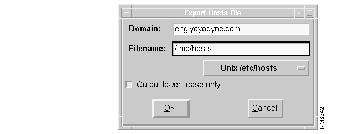
Step 2 Enter the name of the domain from which you want to extract host table data.
Step 3 Enter the name of the host table file in which you want to save the zone data. If you specify a relative pathname, it will be relative to the directory you were in when you started the DNM Browser.
Step 4 Choose "HOSTS.TXT (RFC 952)" for an RFC952-compliant host table or "Unix /etc/hosts" for Unix-style host table file format from the pop-up menu.
Step 5 To save names in only lowercase characters, enable the Output lower-case only checkbox. The default is to preserve the case as you typed it.
Step 6 Click on OK.
The DNM Browser's Export Zone and Import Zone functions let you copy and paste zones.
Select the domain at the top of the zone you want to copy, then select Export Zone from the File menu to export the zone.
To paste the zone, select Import Zone from the File menu; then specify a new domain name in the Import Zone File dialog's Domain field.
The DNM server lets multiple users modify zones at the same time with the following limitations:
 | Caution If you are running the Cisco DHCP/BootP service, it will not be able to update the DNM server while the DNM server is locked. |
The DNM Browser lets you specify preferences for how it presents information and how it responds when you modify information.
To modify DNM Browser preferences:
Step 1 Choose Settings... from the Options menu. The Settings dialog appears. Preferences are organized in four tabs in the Settings window.
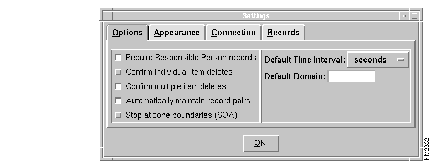
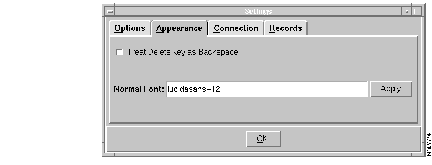
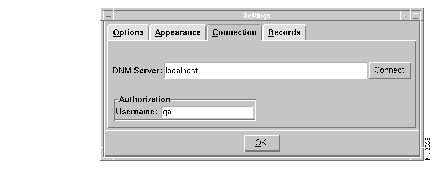
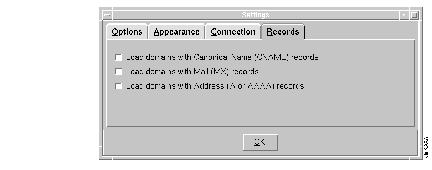
For descriptions of DNM Browser preferences, see Table 3-2 on page 3-24.
Step 2 Edit the DNM Browser preferences as desired.
To save your preferences, click on OK.
| Tab | Parameter | Description |
|---|---|---|
| Options | Require Responsible Person records | Whether the DNM Browser requires that you enter a responsible person record when adding new domains. Default: disabled. |
| Confirm individual item deletes | Whether the DNM Browser prompts you before letting you delete individual domains. Default: disabled. | |
| Confirm multiple item deletes | Whether the DNM Browser prompts you before letting you delete a group of domains. Default: enabled. | |
| Automatically maintain record pairs | Whether the DNM server makes appropriate changes to a spouse record when a record changes. For example, the spouse of an A record is a PTR record, and vice versa. This also applies to the CNAME and fake *ANAME records. Default: enabled. | |
| Stop at zone boundaries (SOA) | Whether to stop at SOA records that are the zone boundaries when executing commands that operate on trees (for example, the Delete and Cleanup commands in the Edit menu). Default: disabled. | |
| Default time interval | The units (seconds, minutes, hours, days, or weeks) in which time entries in the Authority tab of the Edit Resource Records window are displayed. The default time interval is used for the SOA record entries of Refresh, Retry, Expire Time, and Minimum TTL (time-to-live). Default: seconds. | |
| Default domain | Which domain to use for commands in the Edit menu if no domain is selected in the main Browser window. Default: (none). | |
| Show pointer information in tree | Whether to display pointers in the main DNM Browser window. | |
| Appearance | Treat Delete key as Backspace | Whether the DNM Browser treats the Delete key as a Backspace key. Default: enabled. |
| Normal Font | The font the DNM Browser uses to display all dialogs. Default: (depends on the display). | |
| Connection | DNM Server | The IP address or fully qualified host name of the default DNM server to which the DNM Browser connects when it starts. Default: localhost (the host on which the DNM Browser is running). |
| Records | Load domains with CNAME records | Whether the DNM Browser displays domains that contain only canonical names (aliases) for other domains. Default: enabled. |
| Load domains with Mail (MX) records | Whether the DNM Browser displays domains that contain only mail exchange (MX) records for other domains. Default: enabled. | |
| Load domains with Address (A or AAAA) records | Whether the DNM Browser displays domains that contain only IP address records. Default: enabled. |
|
|